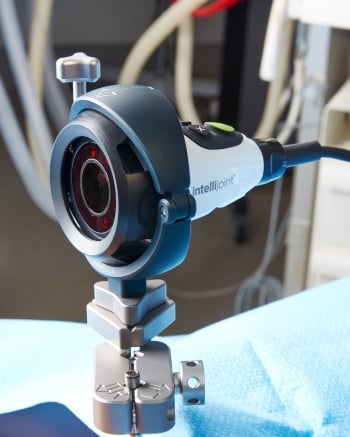Total Hip Replacement: A Brief History of the Evolution
The journey to modern hip replacement has been a long and innovative one. People suffering from hip pain dates back as far as human existence but until recently had no reliable cure. Luckily for us, the last century has been filled with orthopaedic advancements to help with these life-altering pains.
Today, hip replacement surgery can help to relieve pain, aid patients in returning to near-normal function, and improve the health-related quality of life1. Total Hip Replacement surgery has come a long way from its first attempts due to new technologies, the design of implants, and surgical technique improvements. These include advancements in implant material, fixation, bearing surfaces, sizing, minimally invasive tissue-sparing approaches, pain management protocols, and technologies like computer-assisted surgical devices and robotics. Modern total hip replacements have been shown to reliably decrease pain and improve function and quality of life in patients with advanced hip disease at up to 25–30 years of follow-up2,3.
But how did we get here?
The First Recorded Attempt of a Hip Replacement
Around 130 years ago, in 1891, German Professor Themistocles Glück made the earliest recorded attempts at hip replacement surgery. His motivation was to help his patients suffering from tuberculosis that weakened the body and caused damage to their hip joints. Glück created an implantable hip prosthesis fashioned of ivory and affixed with nickel-plated screws.

A Test of Glass
In 1925, Marius Smith-Petersen an American doctor tested an implanted implant mold made of glass. The glass mold implant was a hollow ball that fit over the femoral head to provide a new smooth surface for improving hip movement. It was initially successful; however, the glass could not hold up under the pressures of the joint, which led to shattering in the patient.
Pedal to the Metal
In 1953, George McKee, an American surgeon began to use a metal-on-metal prosthesis. These were the first surgeries where both the ball and socket were replaced. The early success of these implants was quickly overshadowed when metal pieces and particles broke off due to wear and tear causing complications.
The Father of Modern Total Hip Replacement
Sir John Charnley, an orthopaedic surgeon at the Manchester Royal Infirmary, is considered the father of modern THR. In the late 1950s, Charnley created a prosthesis inspired by the work of dentists by fashioning an implant with acrylic bone cement. This cemented hip replacement became popular due to the cement’s two main features; its toughness and ability to be used as grout to improve the fit of the implant.
Charnley’s design was a low friction solution improving patient movement post-surgery that solved the squeaking noise heard from other implant solutions at this time. His design also included a smaller femoral head which reduced implant wear over time improving the life span and success of the surgery.
Overall, Charnley’s contributions laid the groundwork for today’s modern implant designs and surgical techniques.
From Charnley until now...
Since Dr. Charnley’s introduction of the modern hip replacement, implant designs have improved to offer cementless fixation – or press-fit fixation – options, larger femoral head sizes to reduce dislocation risk, and improvements in bearing surface materials – notably the highly cross-linked polyethylene which further reduced wear and tear rates.
However, not all improvements have come from implant design. Surgical approach improvements, from smaller skin incisions to muscle-sparing approaches, have further reduced surgical recovery time and post-op aesthetics.
Pain management and anesthesia advancements have also allowed for earlier discharge from facilities. Some of the earliest hip replacements required multi-month stays in hospitals. These have been drastically shortened over time to multi-day stays, and now to even outpatient total hip replacement performed in ambulatory surgical centers. Now patients have the option to be admitted and discharged the same day in either a hospital or surgery center setting.
Navigating Better Results with the Help of Technology

Believe it or not, computer-assisted surgery (CAS) has been around since the early 1990s. In a CAS procedure, the surgeon uses a combination of instruments and computer software to assist with implant position and orientation. The first total joint replacement performed with computer assistance was a knee replacement in 1997.
After these first pioneering surgeries, CAS expanded throughout the late 1990s and early 2000s to both knee and hip replacements.
Fast forward 20 years and the advancements of medical imaging, computing capabilities, and medical knowledge in orthopaedics have allowed computer-assisted surgery – both navigation & robotics – to deliver improved surgeries through better preoperative planning, intraoperative accuracy, precision, and real-time feedback.
This area in orthopaedics is changing rapidly with new types of technology offerings every year. Patients and surgeons now have many choices beyond implant selection including how they’d like to plan their surgeries, what kind of imaging is appropriate for their individual needs, and what tools they use to deliver these plans.
Looking Forward...
We’re fortunate to live in a time where we can reliably address joint pain without risking shattered glass or broken metal throughout our hips. Thanks to the last 100 years of innovation and current trends, we can confidently address the pains that have caused immobility and severe hip pain in millions of people around the world. We’re excited to see what the next 100 years of innovation will bring to the orthopaedics industry.
To learn more about how Intellijoint is helping to advance total hip replacement, visit Intellijoint HIP.
Sources:
- Deep, K., Shankar, S., & Mahendra, A. (2017). Computer assisted navigation in total knee and hip arthroplasty. SICOT-J, 3, 50. https://doi.org/10.1051/sicotj/2017034
- Callaghan JJ, Bracha P, Liu SS, et al. Survivorship of a Charnley total hip arthroplasty. A concise follow-up, at a minimum of thirty-five years, of previous reports. J Bone Joint Surg Am. 2009;91:2617–21.
- Klapach AS, Callaghan JJ, Goetz DD, et al. Charnley total hip arthroplasty with use of improved cementing techniques: a minimum twenty-year follow-up study. J Bone Joint Surg Am. 2001;83-a:1840–8.
